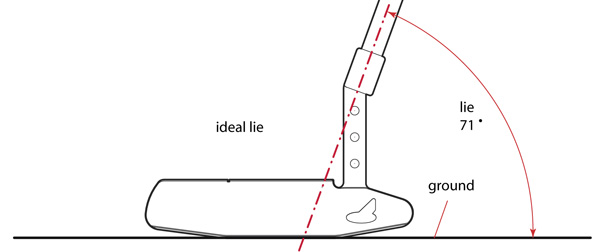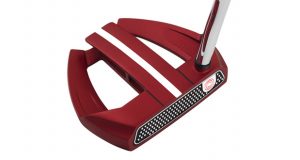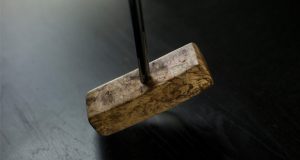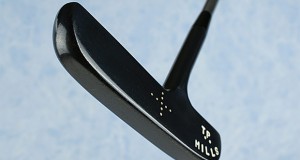Putter fitting is sort of like eating your vegetables. You know it’s better for you, but isn’t it just easier (and more fun) to pull into Krispy Kreme and gorge on a doughnut?
It’s the same with putter fitting, according to our friends in the retail golf business, who tell us that the average recreational golfer is still giving little or no thought to the fit of the putter they are purchasing. Most golfers either (1) come into the store already set on what brand and line of putter they are going to buy, because they saw it in an advertisement or “hot list,” or on television in the hands of a tour pro; or (2) they fiddle around with a variety of different putters and buy one on impulse because of the way it looks or because it sank a few putts on the demonstration green.
In both cases, the question of whether the putter actually fits remains unanswered, because it was never really asked.
Ironically, the educational emphasis on putter fitting has never been greater. Most putter companies now offer a range of custom fitting options, and some offer online fitting tools. PING Golf has even developed a putter fitting app. Here at PutterZone.com, we wrote the first guide dedicated exclusively to putter fitting. Putter fitting articles seemingly pop up every week in newspapers, magazines and web sites across the nation.
So why aren’t more golfers jumping on board? Why do golfers want to buy a putter they saw being used on tour, but disregard the fact that the professional they saw using that putter was personally fit for it? Why wouldn’t a golfer want to seek a better fit for better results on the green?
We suspect that there’s still a sense that putter fitting is either too complicated or difficult to attain. Of course, that’s not true. But if you’re in that camp, then it’s time to eat your proverbial vegetables and do a little research. We’re not asking you to eat a bucket full of kale and carrots, but rather to take a few simple steps toward better putting health.
On that note, here are the seven core fundamentals of putter fitting in a nutshell, along with the degree of ease in attaining them.
Length
The proper putter length will help you achieve your optimal setup for a more fluid and repeatable stroke. Easy—most putters are available in a variety of lengths. Some companies offer lengths down to the half inch.
Lie Angle
The proper lie angle will give you a better chance of keeping the ball on line, and will help you avoid mystifying misses. Moderately easy—many, but not all, companies over custom lie angles. You can also have your putter bent by a fitter to a custom lie angle.
Loft
The proper loft will help the ball achieve true roll more quickly, minimizing bouncing and skidding for enhanced accuracy and distance control. Moderately hard—custom lofts still lag in availability behind custom lie angles and lengths. You can also have your putter bent by a fitter to a custom loft.
Balance
Matching the balance of a putter to your personal stroke will foster a smoother, more reliable path from takeaway through impact. Easy—putters come in a wide range of balance configurations.
Alignment
Finding a putter that can visually confirm and conform to your target line will ensure consistent accuracy. Easy—the range of alignment aids and head shapes has never been greater.
Weighting
The right swingweight for your physique and mechanics will enable you to strike a beneficial balance between touch and distance control. Easy—the range of available head weights has never been greater.
Grip
The right grip for your hands will breed comfort and confidence, and will help you make a consistent stroke. Moderately easy—many, but not all, companies offer custom grip options. You can also buy an aftermarket grip and have it installed, it’s quick and affordable.
So there you have it: six of the seven fundamentals are either easy or moderately easy to attain, and they are right at your fingertips. For example, if you shop online with SeeMore, Never Compromise, Piretti and several other putter companies, you have immediate options to customize your length, lie angle and grip. Along the way, you can choose from models that exhibit different weights, balance configurations and alignment features. In some cases, you can request a custom loft, too. In other words, you don’t need a tour van to customize your putter.
So how to take advantage of these options? You merely need to have a better understanding of what they are and how to apply them.
On that note, you can peruse our complimentary series of putter fitting tips that delve into each of the putter fitting fundamentals. And if you want to dig a bit deeper, consider Putter Perfection, our acclaimed putter fitting guide. If you have questions, don’t hesitate to contact us.
Your journey to a better fit starts today. Happy trails!
 PutterZone – Best Putter Reviews
PutterZone – Best Putter Reviews





I used to think that paying for a real professional fitting (like an Edel or Sones or ??) and then paying $400 for a putter that optimizes all the variables you mention was a waste of money. However, when you start doing a crude multiplication of possibilities for all your variables, you can easily get to a number over a million variations. Unless you are someone WAY beyond the self awareness level of the average golfer, you are highly unlikely to approach optimization. OTOH, putter shopping is fun, just look in my garage 🙂
A fitting process should really begin with a simple lesson in setup and stroke of a putt. Why? All the variables have a dependency on the setup and stroke you attempt. The closer you are to something resembling “standard”, the more likely you are to find a good fit. If you insist on a “unique” setup, an “easy” variable like length quickly becomes meaningless.
A nit: your graphic implies that 71 degrees is “the” ideal lie.
Yeah, good nitpick. It’s from a graphic generously provided by Never Compromise. The original had companion graphics showing toe up and heel up at other lie angles, and how adjusting it to 71 in this instance was ideal. But the full graphic was too wide to include. The intent was to simply show the uninitiated was lie angle is.
Excellent observations about fitting variables and how your own setup and stroke shape the fitting process. Those are points I try to make in Putter Perfection, too. Thanks!